Shooting for product-led growth without understanding product-market fit can be detrimental to startups that are hungry for acquisition yet not knowledge-ready to begin acquiring in the right places.
Simultaneously, failing to identify product-market fit early on can lead to building products for the wrong people while missing growth opportunities with the right ones.
Whether you consider product-market fit pre-launch or post-launch, failing to do so can lead to the eventual loss of a great idea. It’s time to save some products.
What is product-market fit?
How to determine product-market fit
How to measure product-market fit
Frameworks to help you achieve product-market fit
Hopefully, by the end of this piece, the product-market fit will be a metric you’re not only tracking, but you’re leading with. Read on to find out why.
What is product-market fit?
In a nutshell, product-market fit (PMF) is how well your product is received and used by a group of people. Understanding product-market fit means you understand who uses your product or service; and that your product is valuable to these people.
There have been a few game-changers to the product-market fit definition over the years. We can break it down into five core areas when digging further into what product-market fit actually is.
1. Identifying a value proposition
“Identifying a compelling value hypothesis is what I call finding product/market fit.”
– Andy Rachleff, Executive Chairman at Wealthfront
Rachleff said it himself: “growth is sexy,” yet, “growth without value to the customer is likely to lead nowhere–or worse, to a big flameout.” Rachleff is a firm believer that product-market fit comes by determining your value hypothesis first, then your growth hypothesis.
A growth hypothesis is an easy part; identifying your keywords, assigning an ad spend, putting together marketing campaigns. Whether you measure growth via traffic, signups, or free trials deployed, growth is easy with the right strategy. However, if it’s not met with value, then you’ll see knee-trembling churn rates or failing conversions altogether.
Identifying your value proposition is the tricky part, and it needs to come first. That’s determining your product-marketing fit.
2. Building something you need
“Who wants this [product] so much that they'll use it even when it's a crappy version one made by a two-person startup they've never heard of?”
– Paul Graham, Co-Founder of Y Combinator
Build something people want and start with yourself.
Paul Graham, Co-Founder at Y Combinator, believes product-market fit comes when people build products that they need. Graham explains that any product built outside of personal needs are “sitcom” start-up ideas—make-belief problems that people think others may want solutions to but in reality don’t need or can get by without.
When you lock down a solution idea that you need, you can build something with a product-market fit, as you are a part of that market.
3. Having a problem worth solving
"The Product/market fit process is stage-based, time-boxed, and outcome (vs. output) driven.”
– Ash Maurya, Founder of Leanstack
You have the right solution to a problem worth solving, and now it’s identifying who else has that problem.
Ash Maurya also believes that the product-market fit process doesn’t need to be aimless wandering, that it can be structured and less wasteful than what many product teams fear.
It can be “a series of more manageable sub-stages, each with a clear business model outcome, deliverable in 90-day time-boxes.” Leanstack built the Continuous Innovation Framework with these attributes in mind, and this is what it looks like.
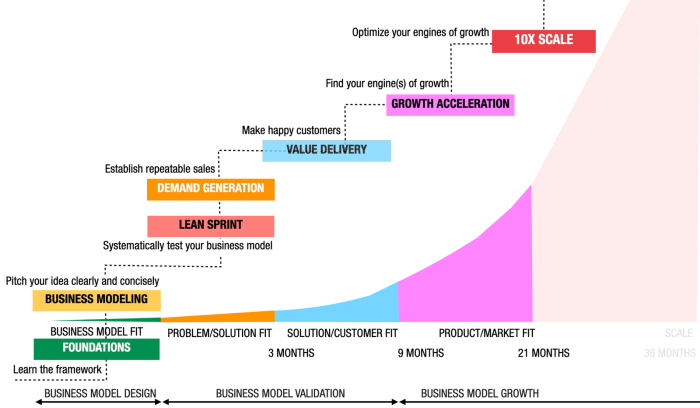
4. Winning word-of-mouth growth
“Do any users love our product so much they spontaneously tell other people to use it?”
– Sam Altman, Co-Founder and CEO at OpenAI
Sam Altman, Co-Founder and CEO of OpenAI, wrote a great short piece on early-stage startups and their requirements before growth. In this article, he affirmed the importance of answering this question before focusing on crazy growth goals. These goals—on a short-term basis—may impress investors yet are not sustainable.
Altman says that answering this question pre-growth is the “critical ingredient for companies that do really well” and helps develop a sustainable mission.
5. A pull from the market
"Product-market fit is a massive pull from the market"
– Patrick Vlaskovits, author of The Lean Entrepreneur
Vlaskovits' book, The Lean Entrepreneur, deals with how founders create great ideas, disrupt markets, and generate market pull. In other words, finding the right product-market fit is generating a demand for your product that you almost can’t keep up with.
How can you determine product-market fit?
This is something we’re all striving toward. You have to launch a product before being 100% confident you’ve found your PMF, which is the leap of faith many teams have to take. However, you can take a few methods to help find the product-market fit quicker than most.

Identifying your product-market fit is not easy but it can be done. First, you need to find an audience to target with your product. Next, you need to find a problem of that audience that your product can solve. Then you need to find what unique value does your product give and then you are ready to develop an MVP.
It doesn’t need to be based on gut instinct until you strike lucky. Here are five proven methods to help you make this process as lean as possible and focus on product-led growth.
Method #1: Talk to your customers
Your biggest asset, no matter how many are in it, is your current user base. These people are your brand ambassadors, product champions, and the bare bones of your future community.
Plus, if you’ve run an NPS survey, you’ll have identified the promoters within your current user base—these people are more likely to provide actionable feedback on your product. However, don’t limit your conversations to only your promoters. Your detractors and passive users are also critical for providing feedback and highlighting room for improvement or user trends. Think of unique ways you can talk to your customers through calls, interviews, focus groups, surveys, and polls.
All of these methods can provide different data sets for you to work from.

You will not know the product-market fit for sure until you test with customers and figure out if they recognize the value of your product. You need to figure out not only how well the product meets a need but if the customer is willing to pay for it.
Don’t be afraid to do some customer development and talk to your customers—you may need to be a little pushy at first to get some feedback from them, especially if they’re not used to hearing from you. Once people understand your efforts and that their input can potentially build a better product, they’ll be willing to donate their time.

We found our PMF by launching a closed beta version of our app before we started openly selling the product. For a few months, beta users tested the app, finding out what works and what doesn’t, attempting to break it and find a place for it in their marketing strategies. Through this beta testing, we determined that there is a definite need for our product and that we should finalize the app and sell it.
Method #2: Make it every team’s job
Every team in your company is responsible for your product success—not just the product team! Identify ways other teams can determine PMF with their data and resources.
Human Resources: Employer branding personas and tactics, internal brand champions, and candidate personas can help identify your audience.
Finance: Payment method trends can be a fantastic insight into how your users prefer to pay and plans that work best for them. This can lead to developing more user-centric pricing plans and payment options.
Marketing & Sales: These teams have copious amounts of consumer behavior data and demographic data to inform your strategy and find the right fit quicker.
Method #3: Open your roadmap to feedback
Great product roadmaps are not focused on the product; they’re focused on the customer. You can do this by continuously collecting customer feedback about the existing product, new feature requirements, and improvements your customer point out as important to them.

Product-market fit is all about how happy your product makes your customers and what kind of results they can get from it. In the end, sales don’t matter if your users don’t reap any benefits from it.
Of course, there are a few steps you need to take to get there first. Number one is mapping your customer journey in the first place, the entire customer journey from the problem that inspires search to brand discovery, right through to product onboarding and referrals.
When you implement in-product feedback opportunities throughout the journey, your customers will begin to build the product for you, essentially ensuring your product is a fit for the right market.
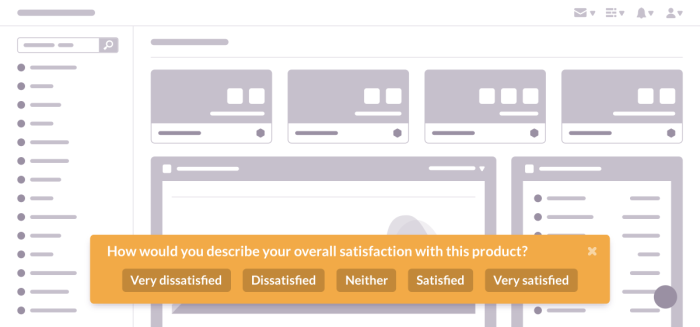
Method #4: Test messaging and features with budget
This method is a great way to determine fit, especially as your product and brand are finding a voice online. Experiment with the messaging, tone, and highlighted features on paid ads. You can essentially gather customer engagement data among different audience types by using ads. Build custom audiences, and try it out.
Of course, this takes a certain amount of budget to get enough data that you can strike a hypothesis from. However, if it helps, determine your market as well as what that market values. It can be well worth it in the long run.
How to measure product-market fit
It’s one thing to determine your product-market fit, but you also need a way to measure it and track the progress of your product.
Sean Ellis, the author of the book Hacking Growth, discovered that a correlating number between startups that had product-market fit and growth success sits at 40%. IT means that, if your product has a market fit of 39% or less, you’re going to struggle for growth and perhaps need to go back to the drawing board before you start pumping resources into growth strategies.
We’ve put together four practical ways you can measure product-market fit.
Run the product-market fit survey
The product-market survey starts with a simple question:
“How would you feel if you could no longer use this product?”
The multiple-choice answers are something along the line of "very disappointed", "somewhat disappointed", and "not disappointed".
Depending on the answers you can expand and ask other product-market fit survey questions such as:
Have you recommended Simulator by GoPractice! to anyone?
What would you likely use as an alternative if this product was no longer available?
What is the primary benefit that you have received from this product?
How can we improve this product to better meet your needs?
Sean Ellis and GoPractice have developed the PMFsurvey as a free tool you can use to run the test and measure your company’s PMF.
Note: You’re aiming for a 40% response rate on “very disappointed” to affirm you have a product-market fit. If you’re not hitting this response rate, then take a few steps back, and work on product improvements. If you are, then you may proceed to growth!
Measure against growth metrics
Your growth metrics can also play a role in measuring your fit. Some of your growth data can help identify if you’ve found a PMF, as well as highlight areas for potential work before pushing growth any further.
As great as qualitative data is from talking to your customer, you also need quantitative data to help drive your hypothesis home.
Let's take a look at some growth metrics that can be useful here.
Metric #1: Retention rate
The stickiness of your product in your users' hands showcases if you’ve got it into the right set of hands in the first place. Of course, other factors come into play here.
Was your user onboarding efficient enough?
Are your customer success teams performing well?
Was your product positioning on point in the first place?
Retention rates of 20% are a good indicator you’ve found your product-market fit. Alarming churn rates can certainly suggest if you’ve got some work to do.
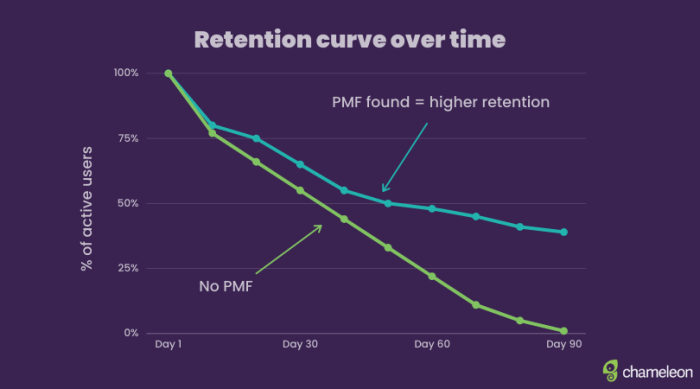
Here's what Lilia Gorbachik, Product Manager at Intermedia has to say on this topic.

Try to understand why your customers stay with you and whether they are attached to your product. If they stay only because you have the lowest price, then they switch the day your competitor will offer a new promo. If your customers are attached to the product because they love it and it became a part of their routine, then generally you are on the right track.
Metric #2: LTV:CAC
If you’re investing a lot in the paid acquisition, this metric is one to watch in your early years of quests for growth—your sprouting years, let’s say.
In the SaaS world, you want to hit a 3:1 ratio if you want your product to be profitable. However, if your cost per acquisition is higher than the total amount of money you make per customer, you either need to focus on retention, tweak your acquisitions strategy, redo your pricing plans, or all of the above.
Metric #3: Virality
Are your users loyal enough to share your product with friends and colleagues? Your product’s word-of-mouth virality is a huge determining factor in your product-market fit.
In fact, it’s so much of a contributing factor that one of the most common follow-up questions in the product-market fit survey is:
“Have you recommended [product name] to anyone?”
With the common multiple-choice answers being:
Already recommended
Wouldn’t recommend
Metric #4: AARRR a.k.a. Pirate Metrics
You thought you were about to go through an entire product marketing article without our eye-patch-wearing, sea-conquering, friendly folk? Uh-uh. Acquisition, activation, retention, referral, and revenue, the 5-step framework known as pirate metrics is still quite relevant for business growth.

The best way to measure success is, of course, the number of new customers. At the same time, you want to take a look at your in-app metrics and make sure that those who purchase it actually use the app. In other words, the adoption rate is your tell-tale sign that you achieved a good product-market fit.
A word of caution here, leadership often shoots for vanity metrics to impress stakeholders. Just because your acquisition rates are incredible, it doesn’t mean you’ve found your product-market fit; the same can be said for activation.
Align on which metrics matter to identifying your PMF, and which transition metrics too. For example, the percentage of acquired users that transition to activation and so on.

We measure the revenue that our customers get from using our software. If they make money from it, it means that it’s doing its purpose as sales software. For our customers, this number is measured in millions of dollars earned by using our tool every year - so that’s a pretty good sign that we have a product-market fit.
Metric #5: NPS
Your Net Promoter Score (NPS) is also a very good indicator of your product-market fit. It helps you understand whether people truly love your product.
Much like the PMF survey, the NPS survey runs off of one simple question:
“How likely are you to recommend this product to a friend or colleague?”
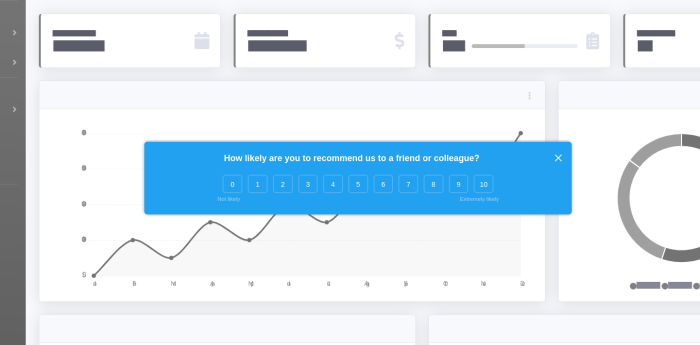
People whose answers range from 0 to 6 are called Detractors, those who respond with 7 or 8 are known as Passives, while those who answer with 9 or 10 are Promoters.
Take note of your Promoters, Passives, and Detractors. If, after the first time you run an NPS survey to your user base, you see mostly Promoters, you’re heading in the right direction.
However, if you’re getting mostly Detractors, then head back to the drawing board before you go for another growth round.

You need to measure how satisfied your users are with your product, their level of engagement with your product, how often they use it, and how many new users with referrals. If you get great numbers for all or most of these, you can expect that you have a product-market fit in your hands.

On-Demand Webinar: How to Use Microsurveys
Equip your team with a modern approach to user feedback that powers product development ⚡
Metric #6: Organic leads
This is a much softer metric to look at. How many leads are you getting in that don’t come through a paid source?
These leads can come through direct product name searches or via referrals. If your organic leads metric is constantly growing, it means you understand your ideal customer profile (ICP), and they understand you. Product-market fit: check.
Frameworks to help you on your PMF journey
Okay, let’s recap. You’re now a wizard with PMF. You know how to determine product-market fit as well as how to measure it. Check, check, check.
The last thing to do is to introduce the PMF process to your product team and build a more prosperous business. So, how do you do it?
Here are two tried and tested frameworks to try with your team.
The Lean Product Process
Ever heard of the Product-Market Fit Pyramid? No? Not to worry, read on.
The PMF Pyramid uses five actionable components to help you achieve product-market fit. Originating from The Lean Product Playbook, this process helps you hypothesize, test, and tweak each step of the pyramid until you’ve secured your fit successfully.
The Product-Market Fit Pyramid, created by Dan Olsen, looks like this:
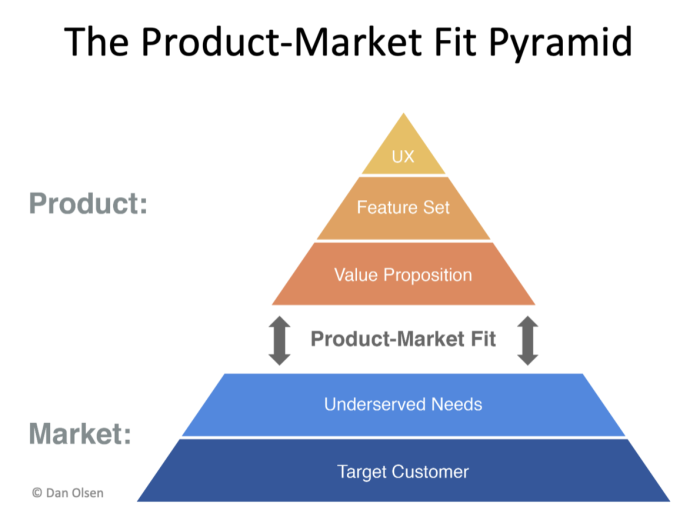
Of course, as with any successful pyramid, you start from the bottom and work your way up, so let’s start with these foundations.
1. Determine your ICP
What does your ideal customer profile look like? Who are you going for, and what types of personas are you likely to encounter within this ICP?
This is a great step to do with the entire company and for teams to combine data sources and observations.
2. Research underserved customer needs
This step largely focuses on your competitive landscape. What are your customers currently using? What’s their switch moment?
Identify if your ICPs are switching from old ways of doing things to your SaaS solution or if they’re potentially switching from a competitor model that isn’t quite satisfying them. Identify their ‘underserved’ needs, and you build a product with a competitive edge.
By this point, you should have developed a product-market fit by understanding who your customers are and what they need. The next steps are building on this.
3. Define your value proposition
Your value proposition, your elevator pitch, whatever you want to call it. You know the needs you need to meet now you need to go about meeting them.
Figure out how you can physically meet customer needs with your product build and figure out how you’re going to communicate this.
4. Lockdown your Minimum Viable Product (MVP)
It’s product strategy 101, and with good reason. Product teams are infamous for spending years pre-launch trying to nail down a product feature set that—in the long run—customers write off as not being useful, or what they were looking for.
You need to get to market and get to it fast. “Fail fast”—in Spotify’s words. Now is not the time to make your product perfect, especially if you’ve already generated a “pull” for your product.
If your fit is right, people will put up with a lesser version of your product because it solves a problem they have right now. Figure out your key features to your MVP, and get to work building.
5. Build prototypes
Whether you’re building high-fidelity or low-fidelity prototypes, prototype testing is critical.
What does your product need to look and feel like?
What UI and UX principles do you need to incorporate to help you fulfill all the work you’ve done prior to this stage?
Run your prototypes by other teams, get their feedback, and ensure your hi-fi prototypes integrate with your other tools.
6. Test your MVP with customers
You are ready to go to market. Congratulations! It’s time to release your MVP and test it with your customers. Run tests that we discussed earlier in this article, use Microsurveys, feedback polls, NPS surveys, everything you can think of to learn from your customer experiences, and continue to optimize your product to fit their needs better.
You may need to tweak features and enhance the higher points of your pyramid. You also need to be prepared to start all over again and go right back to your foundations—pivoting. It’s all okay, as long as you can reiterate your product fast to effectively get it back in the hands of the users who need it.
As Ash Maurya puts it, "aimless wandering prior the PMF fit is popular direction, but it doesn't have to be".
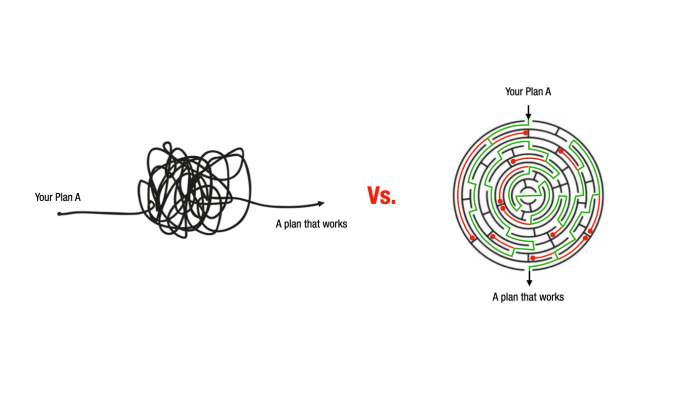
The Superhuman product-market fit engine
“You can always feel when product/market fit is not happening. The customers aren't quite getting value out of the product, word of mouth isn't spreading, usage isn't growing that fast, press reviews are kind of ‘blah,’ the sales cycle takes too long, and lots of deals never close.”
– Rahul Vohra, Founder & CEO of Superhuman
Back in early 2017, Rahul Vohra was waist-deep in years of code and fear of failing with his startup Superhuman.
Yet, Rahul launched, dodged press, avoided growth, and polled their skeletal user base of around 100-200 users with Sean Ellis’s PMF survey. Superhuman asked four questions:

Remember, the benchmark is 40% feeling very disappointed to affirm you’ve found a product-market fit. Superhuman’s results were not so flattering.
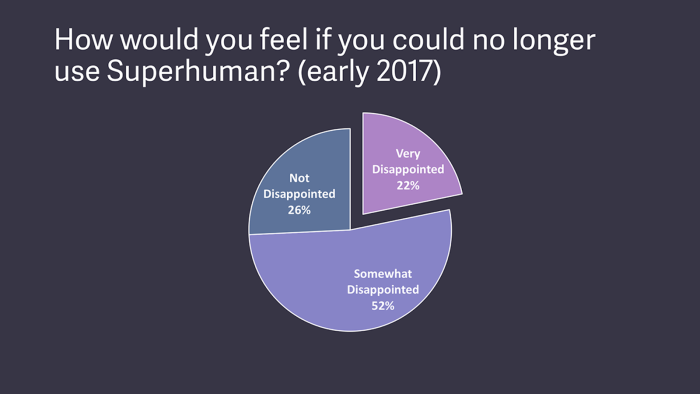
Vohra got to thinking: “What if you could measure product/market fit? Because if you could measure product/market fit, then maybe you could optimize it. And then maybe you could systematically increase product/market fit until you achieved it.”
In turn, Vohra created a 4-step framework for optimizing product-market fit, otherwise known as the Superhuman product-market fit engine. Here's what it entails.
1. Segment to find your supporters
Segment those that answered very disappointed and somewhat disappointed to your PMF survey. Once you’ve done this, identify trends that can help you build personas and lock down your target customer. These trends can be roles at work, industries, company size, and value, whatever data you have. Look for correlations.
2. Convert passive users
Try to convert those users that answered they’d only be ‘somewhat disappointed if they could no longer use your product. These people could be within your ideal market persona. However, they haven’t realized your product’s fullest potential yet.
How can you help them realize your product's potential? How can you realize it yourself? Ask your brand champions. What do they love about your product?
Put your answers into a word cloud, find popular responses and keywords. Next, thread messaging into customer onboarding and even key positioning statements.
3. Build a roadmap from your data
Double down on what users love. Give them more of it, consider it a product feature happy hour. If it’s working well, make it work even better.
Simultaneously, run feedback loops throughout your product to identify what users don’t love or what’s not working well for them.
It’s essential you work on both.
“Start with the lowest hanging fruit of low cost/high impact work [to] deliver improvements immediately.”
– Rahul Vohra, Founder & CEO of Superhuman
4. Rinse, repeat, and grow
Vohra made this metric (company-wide) their most-watched metric, and it paid off. They tested, tweaked, and worked on Superhuman to raise that worrying 22%.
“Within just three-quarters of our work to improve the product, the score nearly doubled to 58%.”
– Rahul Vohra, Founder & CEO of Superhuman
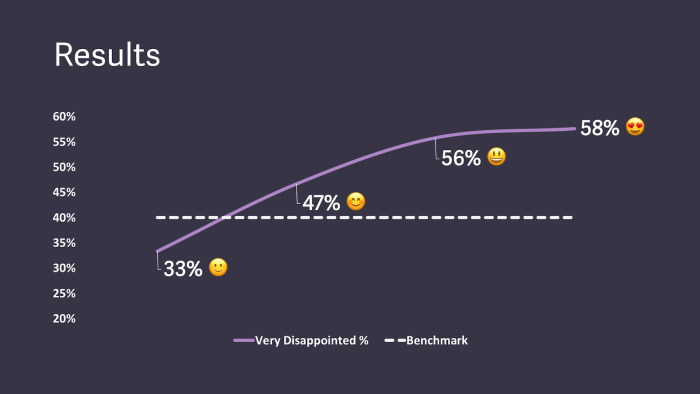
The Superhuman product-market fit engine is something many startups can learn from. It highlights the importance of the PMF metrics placed front and center. It also highlights how your survey can inform other areas of the business and help positive business growth.
Conclusion: Aim to increase your very disappointed users
That’s a wrap! Product-market fit is clearly something most need to strive for, and know you’re not alone in trying to make this process as lean as possible.
Hopefully, this article has made the process that little bit more manageable for you, and you can start championing those users who can’t live without your product.
Strive for a product-market fit and grow your user base in a sustainable way for your business. Next? Rinse, repeat, and continuously improve.

Run product surveys with Chameleon
In-app Microsurveys allow you to capture important user feedback when it's most relevant





